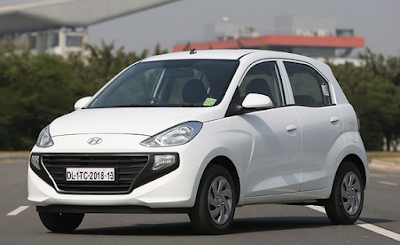 |
| 2019 Hyundai Santro |
Fuses and Relays
A vehicle’s electrical system is protected from electrical overload damage by fuses.
This vehicle has 2 fuse panels, one located in the driver’s side panel bolster, the other in the engine compartment near the battery.
If any of your vehicle’s lights, accessories, or controls do not work, check the appropriate circuit fuse. If a fuse has blown, the element inside the fuse will be melted.
If the electrical system does not work, first check the driver’s side fuse panel.
Before replacing a blown fuse, disconnect the negative battery cable.
Always replace a blown fuse with one of the same rating.
If the replacement fuse blows, this indicates an electrical problem. Avoid using the system involved and immediately consult an authorized HYUNDAI dealer.
Three kinds of fuses are used: blade type for lower amperage rating, slow blow type and multi fuse for higher amperage ratings.
This vehicle has 2 fuse panels, one located in the driver’s side panel bolster, the other in the engine compartment near the battery.
If any of your vehicle’s lights, accessories, or controls do not work, check the appropriate circuit fuse. If a fuse has blown, the element inside the fuse will be melted.
If the electrical system does not work, first check the driver’s side fuse panel.
Before replacing a blown fuse, disconnect the negative battery cable.
Always replace a blown fuse with one of the same rating.
If the replacement fuse blows, this indicates an electrical problem. Avoid using the system involved and immediately consult an authorized HYUNDAI dealer.
Three kinds of fuses are used: blade type for lower amperage rating, slow blow type and multi fuse for higher amperage ratings.
WARNING - Fuse replacement
• Never replace a fuse with anything but another fuse of the same rating.• A higher capacity fuse could cause damage and possibly a fire.
• Never install a wire or aluminum foil instead of the proper fuse - even as a temporary repair. It may cause extensive wiring damage and a possible fire.
NOTICE
Do not use a screwdriver or any other metal object to remove fuses because it may cause a short circuit and damage the system.
Do not use a screwdriver or any other metal object to remove fuses because it may cause a short circuit and damage the system.
When replacing a blown fuse or relay with a new one, make sure the new fuse or relay fits tightly into the clips. The incomplete fastening fuse or relay may cause the vehicle wiring and electric systems damage and a possible fire.
• Do not remove fuses, relays and terminals fastened with bolts or nuts. The fuses, relays and terminals may be fastened incompletely, and it may cause a possible fire.
If fuses, relays and terminals fastened with bolts or nuts are blown, consult an authorized HYUNDAI dealer.
• Do not input any other objects except fuses or relays into fuse/relay terminals such as a driver or wiring. It may cause contact failure and system malfunction.
• Check the blown fuse with the fuse information on the fuse box cover.
• Replace the blown fuse on the same place after turning off the ignition switch and all electric switches and disconnecting the negative battery cable.
• Do not remove fuses, relays and terminals fastened with bolts or nuts. The fuses, relays and terminals may be fastened incompletely, and it may cause a possible fire.
If fuses, relays and terminals fastened with bolts or nuts are blown, consult an authorized HYUNDAI dealer.
• Do not input any other objects except fuses or relays into fuse/relay terminals such as a driver or wiring. It may cause contact failure and system malfunction.
• Check the blown fuse with the fuse information on the fuse box cover.
• Replace the blown fuse on the same place after turning off the ignition switch and all electric switches and disconnecting the negative battery cable.
Instrument panel fuse replacement
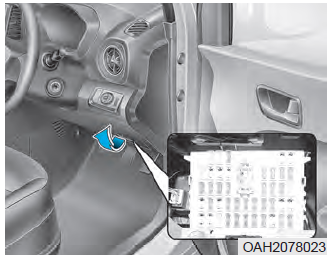 |
| Instrument panel fuse replacement |
1. Turn the ignition switch and all other switches off.
2. Open the fuse panel cover.
3. Pull the suspected fuse straight out. Use the fuse puller provided in the engine compartment fuse panel.
4. Check the removed fuse; replace it if it is blown.
5. Push in a new fuse of the same rating, and make sure it fits tightly in the clips.
If it fits loosely, we recommend that you consult an authorized HYUNDAI dealer.
If you do not have a spare, use a fuse of the same rating from a circuit you may not need for operating the vehicle, such as the cigarette lighter fuse.
If the electrical components do not work and the fuses are OK, check the fuse panel in the engine compartment. If a fuse is blown, it must be replaced.
 |
| Fuse puller in the engine compartment fuse panel |
if your vehicle is parked without being operated for prolonged periods. Use the following procedures before parking the vehicle for prolonged periods.
1. Turn off the engine.
2. Turn off the headlights and tail lights.
3. Open the driver's side panel cover and pull up the memory fuse.
Information
• If the memory fuse is pulled up from the fuse panel, the warning chime, audio, clock and interior lamps, etc., will not operate. Some items must be reset after replacement. Refer to
"Battery" in this chapter.
• Even though the memory fuse is pulled up, the battery can still be discharged by operation of the headlights or other electrical devices.
1. Turn off the engine.
2. Turn off the headlights and tail lights.
3. Open the driver's side panel cover and pull up the memory fuse.
Information
• If the memory fuse is pulled up from the fuse panel, the warning chime, audio, clock and interior lamps, etc., will not operate. Some items must be reset after replacement. Refer to
"Battery" in this chapter.
• Even though the memory fuse is pulled up, the battery can still be discharged by operation of the headlights or other electrical devices.
Engine compartment panel fuse replacement
1. Turn the ignition switch and all other switches off.
2. Remove the fuse box cover by pressing the tab and pulling up the cover.
3. Check the removed fuse; replace it if it is blown. To remove or insert the fuse, use the fuse puller in the engine compartment fuse panel.
4. Push in a new fuse of the same rating, and make sure it fits tightly in the clips. If it fits loosely, we recommend that you consult an authorized HYUNDAI dealer.
NOTICE
After checking the fuse panel in the engine compartment, securely install the fuse panel cover. If not, electrical failures may occur from water leaking in.
2. Remove the fuse box cover by pressing the tab and pulling up the cover.
3. Check the removed fuse; replace it if it is blown. To remove or insert the fuse, use the fuse puller in the engine compartment fuse panel.
4. Push in a new fuse of the same rating, and make sure it fits tightly in the clips. If it fits loosely, we recommend that you consult an authorized HYUNDAI dealer.
NOTICE
After checking the fuse panel in the engine compartment, securely install the fuse panel cover. If not, electrical failures may occur from water leaking in.
Main fuse (Multi fuse)
 |
Main fuse (Multi fuse)
|
If the main fuse is blown, it must be removed as follows:
1. Disconnect the negative battery cable.
2. Remove the nuts shown in the picture above.
3. Replace the fuse with a new one of the same rating.
4. Reinstall in the reverse order of removal.
1. Disconnect the negative battery cable.
2. Remove the nuts shown in the picture above.
3. Replace the fuse with a new one of the same rating.
4. Reinstall in the reverse order of removal.
CAUTION
If the main fuse is not assembled properly, it may cause fire.
If the main fuse is blown, we recommend that you consult an authorized HYUNDAI dealer.
Fuse/relay panel description - Inner fuse panel
Inside the fuse/relay panel covers, you can find the fuse/relay label describing fuse/relay name and capacity.
Information
Not all fuse panel descriptions in this manual may be applicable to your vehicle. It is accurate at the time of printing. When you inspect the fuse panel in your vehicle, refer to the fuse panel label.
 |
| Fuse / relay panel description - Inner fuse panel |
Driver’s side Fuse Specification Chart
P/OUTLET 20A Power Outlet, Cigarette Lighter
ACC ACC 10A Smart Phone Charger, Power Outside Mirror Switch, Audio, A/V & Navigation Head Unit, BCM
A/BAG IND 10A Instrument Cluster
AIR BAG 10A SRS Control Module
T/LAMP 10A Hazard Switch
CLUSTER 10A Instrument Cluster
RR WIPER 15A Rear Wiper Motor, Multifunction Switch
MODULE 6 10A BCM
FRT FOG 15A I/P Junction Block (Front Fog Lamp Relay)
MDPS 2 10A MDPS Unit
IG1 10A BCM, Parking Distance Warning Buzzer, Audio, A/V & Navigation Head Unit
ABS 10A ABS Control Module, ESP Control Module, ESP Switch
B/UP LAMP1 10A Back-Up Lamp Switch, E/R Junction Block (RLY.3)
ACC ACC 10A Smart Phone Charger, Power Outside Mirror Switch, Audio, A/V & Navigation Head Unit, BCM
A/BAG IND 10A Instrument Cluster
AIR BAG 10A SRS Control Module
T/LAMP 10A Hazard Switch
CLUSTER 10A Instrument Cluster
RR WIPER 15A Rear Wiper Motor, Multifunction Switch
MODULE 6 10A BCM
FRT FOG 15A I/P Junction Block (Front Fog Lamp Relay)
MDPS 2 10A MDPS Unit
IG1 10A BCM, Parking Distance Warning Buzzer, Audio, A/V & Navigation Head Unit
ABS 10A ABS Control Module, ESP Control Module, ESP Switch
B/UP LAMP1 10A Back-Up Lamp Switch, E/R Junction Block (RLY.3)
ECU 4 E4 10A ECM, Immobilizer Module
HAZARD 15A I/P Junction Block (Hazard Lamp Relay), Hazard Switch
STOP LAMP 15A Stop Signal Electronic Module
BRAKE SW BRAKE SWITCH 10A Stop Lamp Switch
IMMO 10A Immobilizer Module
TCU T 10A TCM, Vehicle Speed Sensor, ATM Shift Lever IND.
MODULE 3 10A Stop Lamp Switch
IG2 10A I/P Junction Block (Power Window Relay), A/C Control Module, E/R Junction Block (RLY.12), Head Lamp Leveling Actuator LH/RH
HAZARD 15A I/P Junction Block (Hazard Lamp Relay), Hazard Switch
STOP LAMP 15A Stop Signal Electronic Module
BRAKE SW BRAKE SWITCH 10A Stop Lamp Switch
IMMO 10A Immobilizer Module
TCU T 10A TCM, Vehicle Speed Sensor, ATM Shift Lever IND.
MODULE 3 10A Stop Lamp Switch
IG2 10A I/P Junction Block (Power Window Relay), A/C Control Module, E/R Junction Block (RLY.12), Head Lamp Leveling Actuator LH/RH
FRT WIPER 20A Front Wiper Motor, Multifunction Switch
DR LOCK 20A I/P Junction Block (Door Lock Relay), Driver Door Lock Latch
ROOM 10A Room Lamp, Receiver Unit, BCM, Instrument Cluster, Data Link Connector
AUDIO 20A Audio, A/V & Navigation Head Unit
DR LOCK 20A I/P Junction Block (Door Lock Relay), Driver Door Lock Latch
ROOM 10A Room Lamp, Receiver Unit, BCM, Instrument Cluster, Data Link Connector
AUDIO 20A Audio, A/V & Navigation Head Unit
TAIL LH 10A Rear Combination Lamp LH, Head Lamp LH
TAIL RH RH 10A Rear Combination Lamp LH, Head Lamp LH Rear Combination Lamp RH, License Lamp, Haed Lamp RH, Clock Spring, Hazard Switch, ESP Switch, HLLD Switch,
Instrument Cluster, A/C Control Module, ATM Shift Lever IND., Audio, A/V & Navigation Head Unit, USB Jack
START 10A ECM, E/R Junction Block (RLY.2)
H/LAMP 10A E/R Junction Block (RLY.5, RLY.6)
P/WDW LH 25A Front Power Window Switch
P/WDW RH 25A Front Power Window Switch
HTD MIRR 10A Driver/Passenger Power Outside Mirror, ECM, A/C Control Module
TAIL RH RH 10A Rear Combination Lamp LH, Head Lamp LH Rear Combination Lamp RH, License Lamp, Haed Lamp RH, Clock Spring, Hazard Switch, ESP Switch, HLLD Switch,
Instrument Cluster, A/C Control Module, ATM Shift Lever IND., Audio, A/V & Navigation Head Unit, USB Jack
START 10A ECM, E/R Junction Block (RLY.2)
H/LAMP 10A E/R Junction Block (RLY.5, RLY.6)
P/WDW LH 25A Front Power Window Switch
P/WDW RH 25A Front Power Window Switch
HTD MIRR 10A Driver/Passenger Power Outside Mirror, ECM, A/C Control Module
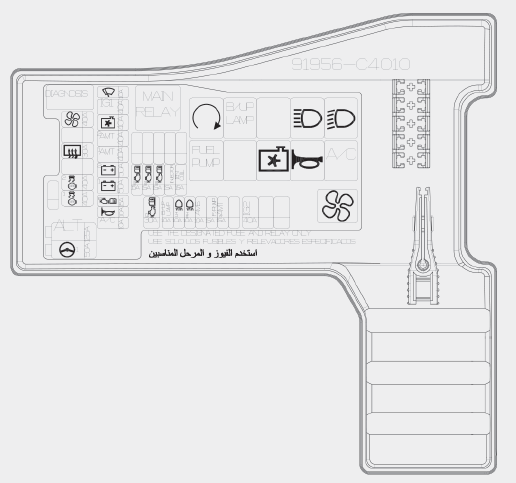 |
| Engine compartment fuse panel Diagram |
Fuse Name .. Fuse Rating .. Circuit Protected
BLOWER 40A E/R Junction Block (RLY.12)
RR HTD 30A I/P Junction Block (HTD MIRR Relay)
ABS 1 40A ABS Control Module, ESP Control Module
ABS 2 40A ABS Control Module, ESP Control Module
IG1 40A Ignition Switch
C/FAN 40A E/R Junction Block (RLY.9)
AMT 2 40A [G4HG] : TCM
AMT 1 40A [G4HG] : TCM
BATT 2 50A I/P Junction Block (F23, F24, F25, F26, F31, Power Window Relay)
BATT 1 50A I/P Junction Block (Power Connector Fuse - F35,F36, Tail Lamp Relay)
ECU 3 15A [G4HG] : ECM
BLOWER 40A E/R Junction Block (RLY.12)
RR HTD 30A I/P Junction Block (HTD MIRR Relay)
ABS 1 40A ABS Control Module, ESP Control Module
ABS 2 40A ABS Control Module, ESP Control Module
IG1 40A Ignition Switch
C/FAN 40A E/R Junction Block (RLY.9)
AMT 2 40A [G4HG] : TCM
AMT 1 40A [G4HG] : TCM
BATT 2 50A I/P Junction Block (F23, F24, F25, F26, F31, Power Window Relay)
BATT 1 50A I/P Junction Block (Power Connector Fuse - F35,F36, Tail Lamp Relay)
ECU 3 15A [G4HG] : ECM
A/CON Air Conditioner 10A E/R Junction Block (RLY.11)
ECU 1 30A E/R Junction Block (RLY.1)
B/UP LAMP 10A [G4HG] : E/R Junction Block (RLY.3)
H/LAMP LH 10A Head Lamp LH
H/LAMP RH 10A Head Lamp RH
AMS 10A [G3LA] : Battery Sensor
F/PUMP 15A E/R Junction Block (RLY.7)
AMT 3 15A [G4HG] : TCM
IG2 40A E/R Junction Block (RLY.2), Ignition Switch
ECU 2 15A [G3LA] : E/R Junction Block (RLY.11), ECM, Purge Control Solenoid Valve, Oxygen Sensor (Up/Down), Camshaft Position Sensor #1/#2, Oil Control Valve #1/#2 [G4HG] : E/R Junction Block (RLY.11), ECM, Purge Control Solenoid Valve
ECU 4 15A [G4HG] : Oxygen Sensor (Up/Down), Front Wheel Sensor RH
ECU 5 (INJECTOR) 15A [G3LA] : E/R Junction Block (RLY.9) [G4HG] : E/R Junction Block (RLY.9), Camshaft Position Sensor, Crankshaft Position Sensor
INJECTOR 15A [G3LA] : E/R Junction Block (RLY.7), Injector #1/#2/#3, ECM [G4HG] : E/R Junction Block (RLY.7), Injector, ECM
IGN COIL IGN COIL 15A [G3LA] : Ignition Coil #1/#2/#3/#4 [G4HG] : Ignition Coil
ALT 125A Alternator, E/R Junction Block (F1, F3, F5, F6)
MDPS 50A MDPS Unit
WIPER 10A ECM
ECU 4 15A [G4HG] : Oxygen Sensor (Up/Down), Front Wheel Sensor RH
ECU 5 (INJECTOR) 15A [G3LA] : E/R Junction Block (RLY.9) [G4HG] : E/R Junction Block (RLY.9), Camshaft Position Sensor, Crankshaft Position Sensor
INJECTOR 15A [G3LA] : E/R Junction Block (RLY.7), Injector #1/#2/#3, ECM [G4HG] : E/R Junction Block (RLY.7), Injector, ECM
IGN COIL IGN COIL 15A [G3LA] : Ignition Coil #1/#2/#3/#4 [G4HG] : Ignition Coil
ALT 125A Alternator, E/R Junction Block (F1, F3, F5, F6)
MDPS 50A MDPS Unit
WIPER 10A ECM
[G3LA] : 1.0 MPI
[G4HG] : 1.1 MPI
[G4HG] : 1.1 MPI

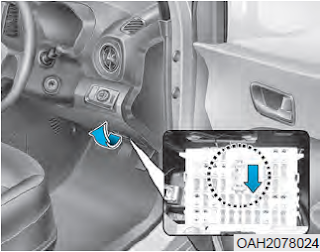
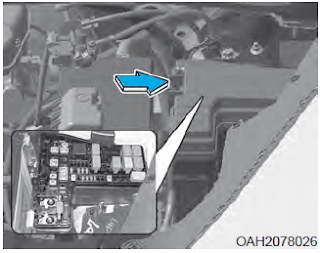

No comments:
Post a Comment